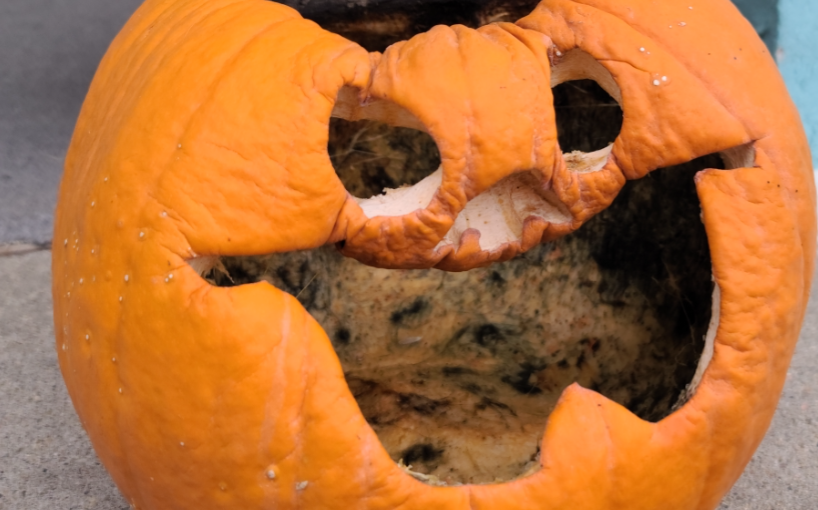Scrolling through social media in September and October and you may see those basic signs of the season: scarves, pumpkin spice lattes, sweaters, and Halloween ideas galore. One of those Halloween ideas is to extend the life of your pumpkins, carved or otherwise, by giving them a treatment with household bleach. Keep scrolling and you might see another post decrying the use of bleach as inhumane and poisoning for wildlife. So which is it? Is bleach safe to use as a sanitizer on your jack-o’-lantern or are you poisoning the neighborhood squirrels? Let’s use our gourd to explore the science.
The bleach acts as a sanitizer, neutralizing fungi and bacteria on the surfaces of the pumpkin that will cause decomposition and rot. Even un-carved pumpkins will eventually succumb to degradation under the right conditions. But if bleach kills fungi and bacteria, will it kill wildlife? The answer is – not if it is used correctly. Bleach, and sodium hypochlorite (the active chemical in bleach) are toxic if consumed directly in concentrated amounts, however, dilute solutions break down quickly in the environment. Products containing sodium hypochlorite, including plain household bleach, are actually approved and labeled for use as a sanitizer by produce farmers to reduce both human pathogens and decomposition microorganisms and extend the shelf life of produce that finds its way to the grocery store, farmers market, and any other avenue from the farmer to the consumer. These wash water sanitizers are used more for reducing cross contamination of from pathogens introduced to the water from dirty produce, but it can reduce the microorganism load on produce items. If used correctly to sanitize the surface of the pumpkins, bleach DOES NOT pose an increased risk to wildlife (or human) health.
What is the proper way to use bleach in sanitizing that pumpkin so that it doesn’t face an early demise?
1) Make sure the pumpkin is clean by washing with plain water or a mild detergent to remove any soil or debris. Sanitizers like bleach are quickly neutralized (used up) on dirty surfaces (this is a good lesson for home cleaning, too – you cannot sanitize a dirty surface).

2) Prepare a DILUTE solution of plain household bleach (unscented, and not “splashless”). The recommended concentration is 200ppm sodium hypochlorite, which you can achieve with 1 Tablespoon of bleach per gallon of water.
3) Apply the solution to the pumpkin using a spray bottle. Alternatively, you can prepare enough solution to dunk the pumpkin(s) and immerse them in the solution. If you are sanitizing a carved pumpkin, I would opt for the spray method – dunking may result in infiltration of the solution in to the exposed flesh. It will still break down since it is a dilute solution, but it will slow down the process since it protects the bleach atoms from air and sun exposure.
4) Allow the pumpkin to air dry. Sanitation is not immediate (keep that in mind for sanitizing surfaces in the home, as well) and wiping can cause cross contamination
If I can do this with a pumpkin, should I be doing this with my other produce?
The short answer is NO. It is not recommended that home grown or purchased produce be washed with any sort of detergent or chemical in the water. Fresh cold water and friction should be sufficient for removing soil and pathogens on the surface. Proper protocols, equipment, and training are needed to make sure sanitation is done properly. Knowing which produce items can and cannot be washed with a sanitizer is important. However, if you are harvesting produce like pumpkins or winter squash for long-term storage you may want to consider sanitation using the above methods.
I don’t want to use bleach, can I use something like vinegar?
There are many sanitizers approved for use by produce growers for sanitation, so bleach is not the only option. For home consumers there aren’t so many options. Vinegar is often mentioned as a wash for produce. I found no direct mention in produce handling guides of using vinegar on pumpkin, but most produce wash solutions use vinegar at a much higher concentration because it is much less effective at sanitation. I found rates ranging from 1/3 c vinegar to 1 c water to 100% undiluted household vinegar for use as a produce wash.
Sources:
Sanitizers Labeled for Use on Produce (Produce Safety Alliance)
Produce Wash Water Sanitizers (UMN)
Guidelines for the use of chlorine bleach as a sanitizer in food processing operations (OSU)
